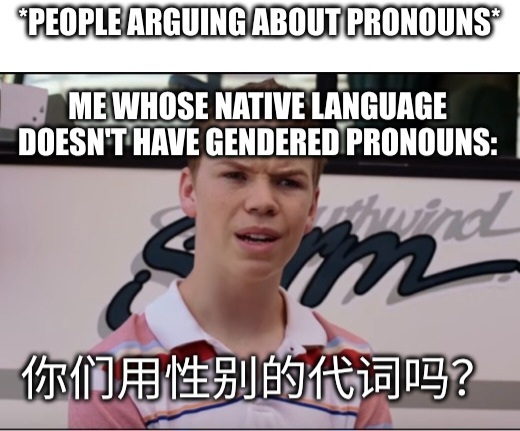Finnish has 'hän' which is an ungendered pronoun. We use that for pets. Often we refer to people instead as 'se' which means 'it'.
Memes
Rules:
- Be civil and nice.
- Try not to excessively repost, as a rule of thumb, wait at least 2 months to do it if you have to.
Oh gendered pronouns are fun in german.
Especially when combining the male and female version of a word to one gender neutral word.
For example doctor:
Arzt (male) + Ärztin (female) = ärzt'in (Singular) / ärzte'innen (Plural)
Meanwhile in Japanese, you get to gender YOURSELF!
in turkish he/she is just "o"
I understood about half of those Chinese words, my 6 years of Chinese are starting to pay off.
what does the half you understand say
It’s not that I understand half the sentance, I understand almost every other word. This means I can’t make an actual sentance out of it and don’t know what this means at all. Much good 6 years has done me.
My language (Bangla) also doesn't really have genders. The only places where we use anything gendered are adjectives and some nouns (especially those denoting relations). But gendered adjectives aren't really used nowadays, the male version is usually treated as neutral.
in my language we have one pronoun for all genders(siya). it just morphs depending on context(siya/sila/niya/nila).
The argument seems to be that, in a language with ungendered pronouns, all genders are included, so you don't need neopronouns for the purpose of inclusion. Nevertheless, you could still replace an ungendered pronoun with a neopronoun to be more accurate, or for other purposes.
Boy English is pretty tame. My native language has gendered pronouns for what feels like every type of relative you can have. I don't see my extended family very often so truthfully I don't even know half of those pronouns. Sometimes a relative pops up out of nowhere and I get all confused about pronouns again. Seriously, like last year at a family gathering my aunt (maybe? idk, she's my grandmother's niece) brought someone and was like "heyyyy yall are related come say hiii" and she was like brand new information to everyone there lol.
